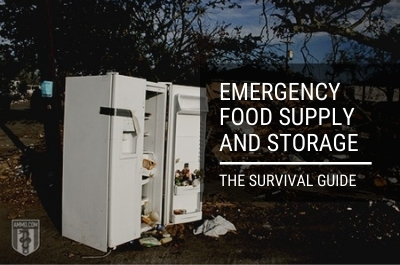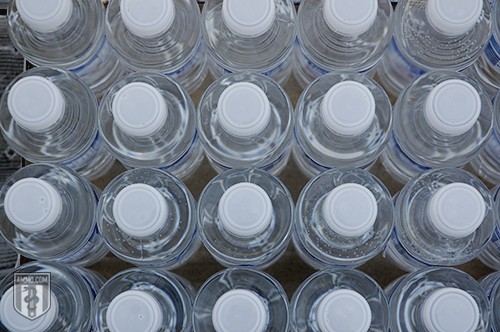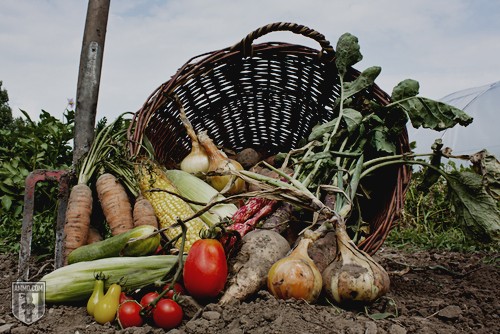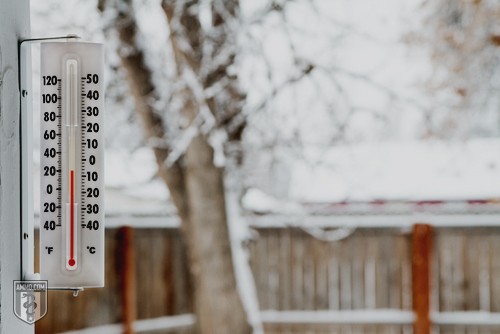Emergency Food Supply And Storage: The Survival Guide
You're free to republish or share any of our articles (either in part or in full), which are licensed under a Creative Commons Attribution 4.0 International License. Our only requirement is that you give Ammo.com appropriate credit by linking to the original article. Spread the word; knowledge is power!
 Could you and your family survive a one-week cut in the food supply chain? It’s not an end-of-the-world scenario, but it’s a possibility that should be prepared for by more than just hardcore preppers. Think about a mysterious illness such as SARS spreading rapidly due to our interconnectivity. Or a heavy snowstorm taking out the power and causing a run on basic supplies at the local supermarket.
Could you and your family survive a one-week cut in the food supply chain? It’s not an end-of-the-world scenario, but it’s a possibility that should be prepared for by more than just hardcore preppers. Think about a mysterious illness such as SARS spreading rapidly due to our interconnectivity. Or a heavy snowstorm taking out the power and causing a run on basic supplies at the local supermarket.
For these sort of unexpected circumstances, having food stocks in place is a prudent move for anyone. Because while a short-term power outage is hardly the zombie apocalypse, the negative effects on food supply could be the same for you and your family.
How Much Food to Store for Emergencies
As you might imagine, even “expert” opinions vary widely when it comes to the amount of food to keep on hand. At a minimum, you should have a week’s worth of food and water – two weeks to a month is even better, and three to six months is ideal if you have the space. The Mormon Church encourages its members to have a one-year food supply on hand for themselves, their family and to help others in the community in the event of a disaster. The short answer is that more food always is better, but you likely have a limited amount of space. Two weeks to a month is a bare minimum, and anything more than a year is probably overkill.
What Food to Store for Emergencies
One good way to kickstart your food supply is to buy a massive amount of beans and rice. That way, if the food supply dries up tomorrow, you’ll have something to eat. These may not be the most appetizing choices, but using this approach will at least give you peace of mind while you build up and diversify your food supply.
Things to consider while diversifying your food supply:
- You’ll need enough calories for you and everyone in your family to survive and thrive.
- Foods like beans, rice, pasta and oats can be used a variety of different ways, giving you a varied menu without buying too much food.
- Keeping high-calorie, high-carb snacks on hand will be helpful during emergencies by giving you a quick supply of calories to burn.
- You can never have too much protein in your emergency food stores.
- Don’t forget cooking basics like oils, salt, sugar, flour, baking soda and powder and vinegar. The same goes for coffee and tea if you’re a big fan of those.
- Convenience foods can really pay off in a disaster scenario. You might not have the wherewithal to make pancakes when there’s a hurricane outside, but you can probably make some “just add water” pancakes to bring a smile to everyone’s face.
- Comfort food is a must, so keep some popcorn, pudding and hard candy around. Even things like pickles and applesauce can help morale when times are tough.
- Backups – and backups for backups – can be had on the cheap. Having a backup supply of meal replacement bars won’t take up much space or much of your budget. Backing that up with MREs is worth its weight in gold.
- Keep track of what you have and rotate as needed. Even emergency supply buckets generally go bad, so know when things need to be replaced.
The Federal Emergency Management Agency has a list of foods they recommend for people to keep on hand for emergencies. This is just a starting guide and something to get you thinking about what you should keep in your home “just in case.”
- Powdered milk in a box
- Powdered milk in cans (lasts longer)
- Dried fruit
- Crackers
- Potatoes
- Condensed canned soups
- Peanut butter and jelly
- Canned fruit, juice and vegetables
- Hard candy
- Canned nuts
- Wheat and flour
- Vegetable oil
- Salt
- Soybeans
- Instant coffee, tea and cocoa
- Bouillon
- Pasta and rice
- Ready-to-eat meals and instant cereals
This is a particularly useful list for people who aren’t prepping, but instead just trying to get enough food and water on hand in case of an emergency. Those thinking a little longer term should consider adding these to the mix:
- Canned and dried meats
- Beans
- Whole grains, which store better than flour
- Spaghetti sauce (for all the dry pasta you have)
- Spices will bring flavor to meals that are otherwise bland
There’s a more extended list of food you should have in your reserves at Prepared LDS Family, which includes a checklist to track what you have and what you need. They break everything down into categories including grains, sugars, milk, oil and fats, meats, beans and legumes, fruits, vegetables, baking items and spices, drinks, condiments, soups and pre-cooked meals, ready-made snacks and vitamins. The list also includes toiletries, cleaning supplies, paper and plastics needed in the event of society breaking down.
Don’t forget about food for babies and pets if they are a part of your family.
How Much Water to Store for Emergencies
 Unless you have a well or live near a clean drinking source of some other kind, it’s important to consider water as part of your food supply. A gallon of water per person per day is a good rule of thumb. While this amount of water can start taking up space, it’s a necessity if the water system shuts down.
Unless you have a well or live near a clean drinking source of some other kind, it’s important to consider water as part of your food supply. A gallon of water per person per day is a good rule of thumb. While this amount of water can start taking up space, it’s a necessity if the water system shuts down.
When looking at things like the federal government’s response to Hurricane Katrina, you would do well to prepare yourself for a major disaster. Think about it: No matter where you live (unless it’s the Idaho panhandle, which is somehow pretty insulated from all potential disasters, including nuclear fallout), there’s the potential for hurricanes, earthquakes, flooding and other natural disasters. You don’t want to be dependant on the federal government in your time of need, so you’d better start getting prepared – even if civilization is unlikely to collapse any time soon.
Cost of Emergency Food Supplies
You’ve probably noticed that this is starting to quickly add up. Whether you’re buying in bulk, getting food buckets or even just picking up canned goods here and there, the cost of an emergency food supply adds up quickly. Even if you’re convinced that the cost of not having an emergency food supply is greater than the cost of having one, that doesn’t magically give you the budget to make it happen.
Again, beans and rice are cheap and will at least give you something to start with. Make that and some good water vessels your first investment. From there, put $20 to $30 a week toward filling your reserve food stores. It’ll take some time, but you’ll soon have what you need in the event of an emergency.
Another strategy is to set months aside for making specific purchases for your food supply. Mormon Channel’s 12-month list will help you make strategic purchases in each month of the year. Even if you don’t choose to load up your emergency food supplies with this method, it can be a good way to check in and make sure that you’re rotating your supplies appropriately.
Emergency Food Storage: Tips
Most of your food should be non-perishable or at least have a long lifespan. If the food supply is breaking down, so is the power supply – so make sure your food will not need refrigeration or any other kind of electricity to be edible.
However, that doesn’t mean you can’t keep any emergency food in a freezer or special refrigerator. Anyone who has ever been through a power outage knows that your fridge and freezer are going to stay cold for quite a long time, provided you don’t open the door any more than you have to.
Meat, poultry, fish and eggs need to be kept at lower than 40 degrees Fahrenheit. For a fridge, that means you have a window of four hours to be completely certain that all your meat is safe. In a freezer, you’ve got 48 hours. So if you know that the food supply will be interrupted, take out all the meat and start cooking. Once you’ve done that, it’s going to keep longer than it would in the fridge. If you want to make the most out of your freezer, keep it as full as possible. The more tightly packed food is, the better it’s going to keep for a longer period of time.
Dry ice and block ice are things you can use to effectively transform your refrigerator into an ice box (much like your grandmother had). Fifty pounds of dry ice can keep your fridge cold enough for two days. But if the food supply chain is going to be out for a longer period of time, you’re basically just kicking the can down the road. Instead, be prepared to use the food that you have.
One piece of equipment you should have is a food thermometer or an appliance thermometer. When the power is out and food supplies are possibly breaking down, you don’t want to be guessing whether or not food is spoiled.
 So what do you do once your refrigerator’s time is up?
So what do you do once your refrigerator’s time is up?
- Meat, Poultry and Seafood: If it’s been at 40 degrees or hotter for more than two hours, it needs to go into the trash without question. That includes not just the meats themselves, but anything with the meat or its broth as an ingredient.
- Cheese: Hard cheese and soft cheese are completely different. Soft cheeses should be treated exactly the same as meat. Hard cheeses are safe until they become moldy. A few hours being warm isn’t going to spoil them, but you should move them to the front of the line for eating.
- Dairy: Nearly all dairy should be treated exactly the same as meat (including baby formula). Butter and margarine are the only exceptions to this rule.
- Eggs: Eggs are like meat. It’s better to throw them out and be safe than to let them sit around, get warm and spoil.
- Casseroles, Stews and Soups: As they probably contain meat or meat broths, these need to be discarded.
- Fruits: Basically all kinds of fruit and fruit juices are going to be safe until they rot. The only exception to this rule is fruit that you have “opened” by cutting or slicing. Get rid of that fruit.
- Vegetables: Most raw vegetables are going to be totally safe – this includes fresh mushrooms and herbs. Cooked vegetables, however, can quickly become dangerous. Other vegetables that are dangerous include pre-cut, pre-washed and packaged greens, opened vegetable juice, baked potatoes, commercial garlic in oil, and potato salad.
- Sauces and Condiments: Condiments are a lot safer than other food on this list. Mayonnaise, tartar sauce and horseradish can become dangerous, but only after more than eight hours above 50 degrees Fahrenheit. Fish and oyster sauces, hoisin sauce, opened cream-based dressings, opened spaghetti sauce jars, and Worcestershire sauce should all be treated the same as meat.
- Pies and Pastries: Cream-filled pastries, and cheese-filled, custard, or chiffon pies are all in the danger zone. Throw them out to be safe.
- Miscellaneous: Cheesecake, refrigerator biscuits, rolls, and cookie dough, cooked pasta, and pasta salads with mayonnaise or vinaigrette should be treated the same as meat.
Your freezer has a whole other set of guidelines relating to food going above zero degrees Fahrenheit. Once food reaches a certain temperature, it can be refrozen – even though it won’t be as appetizing as it once was. Other stuff, however, will simply need to be thrown out. Here’s your guide to what will keep in the freezer and what won’t:
- Meat, Poultry and Seafood: If there are still ice crystals and it feels cold to the touch, it can probably be refrozen. Otherwise, the same rules apply to frozen meat as refrigerated meat. Once it clears the 40-degree mark for more than two hours, it’s time to throw it away.
- Dairy: Dairy products of all kind remain safe so long as they’re cold to the touch. Cheesecake, eggs and egg products can be refrozen as long as they’re only partially thawed. Once dairy products warm up to the danger zone, they need to be thrown out (except for hard cheeses, which will be fine).
- Fruit: Much like refrigerated fruit, frozen fruit is one of your safest bets. The texture and flavor might change from repeated thawing and freezing, but as long as it doesn’t smell, it’s probably safe to eat. There’s no substitute for your nose when it comes to checking out frozen and thawed fruit.
- Vegetables: These are going to have much the same rules as fruit, except they tend to be even more hardy and durable. Once totally thawed, vegetables can enter the danger zone for up to six hours before they need to be thrown out.
- Bread: Unless it has a custard or cheese filling, bread can basically just be stuck back in the freezer once the power comes on and it’s good to go. If there is a cheese or custard filling, they can spend two hours in the danger zone before you have to get rid of them. Pie crusts and homemade bread can be refrozen, provided that they’re still cold.
- Miscellaneous: Flour, cornmeal, nuts, and breakfast items such as waffles, pancakes, and bagels may be refrozen if cold or thawed. Casseroles, including pasta and rice-based dishes, may be refrozen if still cold, but should be discarded if held above 40 degrees Fahrenheit for over two hours. The same is true for frozen meals, entrees, and specialty items like pizza, sausage and biscuits, meat pies, and convenience foods.
Between your fridge and your freezer, you can get through most food emergencies. Filling those is going to get you a couple of weeks, especially if you cook everything right away when the power goes out.
Power Outage Food Safety Rules
 There are some things you should keep in mind if the power goes out and you have to start digging into your emergency food supply:
There are some things you should keep in mind if the power goes out and you have to start digging into your emergency food supply:
- Never taste food to determine whether it’s safe to eat. When in doubt, throw it out.
- If your food begins to thaw, examine each piece of it individually to see if it has thawed too much to be refrozen. There are no shortcuts when it comes to food safety.
- Putting food in the snow is not a safe way to store and keep food cold. The sunlight will heat the food up, even if you pack it in snow. What’s more, there might be bacteria in the snow that will make the food inedible. Observe the rules above: keep it under 40 degrees Fahrenheit, and if it goes above that for more than two hours, throw it out.
- In the event of a fire, throw away all food that got anywhere near the heat. There’s no way to know what food has been heated up and what hasn’t if there’s a fire. Again, always be safe rather than sorry when it comes to food.
- In the event of a flood, throw out all food that has come into contact with flood waters. This includes canned goods. Water supplies should likewise be considered tainted and treated accordingly.
Hopefully, you won’t have to do much with your emergency food supply other than buy it and store it in a cool, clean and dry place. Don’t forget that you can always donate excess supplies, or supplies that will soon expire, to the local homeless shelter or food bank. Having food on hand for an emergency might seem like an unnecessary expense, but remember that a total social collapse isn’t necessary to make it all pay off. Even just two weeks without food and water can be seriously disruptive to your family and your way of life. Plan for the worst and hope for the best.
Preparedness
- Natural Disaster Survival Guide: Your Emergency Checklist
- Emergency Food Supply And Storage: The Survival Guide
- How to Prepare For Flooding: A Guide to Flood Survival
- How to Prepare for a Hurricane: A Survival Guide for Tropical Disasters
- Wildfire Safety Tips: The Ultimate Guide to Heatwave Safety and Preparedness
- Earthquake Survival Guide: How to Prepare for and Survive an Earthquake
- How to Survive a Tsunami: An Expert Tsunami Survival Guide
- How to Survive If the Power Grid Goes Down: Power Grid Failure Preparedness Guide
- How to Prepare for a Tornado: The Definitive Safety Guide
- How to Survive a Terrorist Attack: Prepare, Plan, and Survive
- Living off the Grid? These 8 Essential Off Grid Living Tips Will Help
- Surviving in the Outdoors: An Emergency Guide
- Ammo Storage: How to Store Ammo and Transport it Safely
- Top 27 Online Resources for Survivalists and Preppers
- Cold Weather Preparedness: A Guide to Winter Weather Survival
- Wildcat Cartridges: A Guide to Wildcatting and Customized Rounds
- Get Paid $1,200 to Watch the 12 Best Prepper Movies as You Self-Quarantine to Avoid COVID-19
